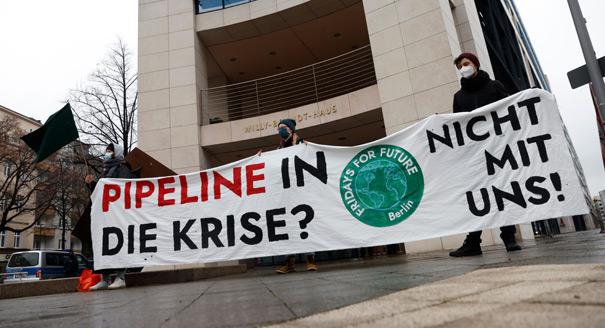Beginning in 2020, Azerbaijani natural gas will flow into Italy for the first time, reducing Italian consumption of Russian gas by one-half. The gas will enter Italy via the Trans Adriatic Pipeline (TAP), which will link Italy, Greece, and Albania to Turkey and Azerbaijan.
The EU intends to use TAP to turn the European gas market into a buyer’s one, a prospect that has put Russian natural gas giant Gazprom on the defensive. So far, however, Gazprom’s plans to thwart the pipeline have failed.
Gazprom already produces more gas than it can sell. RusEnergy, an energy consultancy, estimates that Gazprom is able to produce around 225 billion cubic meters of excess gas per year. That is equal to the amount of Russian gas that Europe and the former Soviet republics import per year combined.
Gazprom’s export markets are indeed quickly drying up; its much-vaunted “pivot to Asia,” which was supposed to revitalize Russian gas exports, has yet to materialize. Plans to build a gas liquefaction plant near Vladivostok have come to a grinding halt, as has a project to build a pipeline to transport gas from Eastern Siberia to the Pacific coast. Similarly, the “Power of Siberia” pipeline, which aims to bring Russian gas into China, seems destined to fail: it won’t even be profitable if prices stay where they are now.
With few opportunities in Asia and a recession suppressing demand at home, Europe is now Gazprom’s only significant market.
But even Gazprom’s position in the European gas market is becoming less and less secure. Gas production in Europe has been falling, but net imports of gas are dropping even faster: net imports fell from 299 billion cubic meters in 2010 to 219 billion cubic meters in 2014 (a slight uptick in 2015 deviated from the long-term trend).
Worst of all for Gazprom, European importers have made a concerted effort to diversify their gas supplies. Perhaps most importantly, the influx of liquefied natural gas (LNG), which has undercut prices in Europe and globally, increasingly threatens Gazprom’s stake in the European market.
As a result of these changes, Europe is gradually becoming a buyer’s market for natural gas. Last year, the EU used only 65 percent of the capacity of the pipelines that bring gas to Europe. Russian pipelines to Europe were particularly empty, operating at only 45 percent of their capacity.
Meanwhile, Russia is encountering difficulties with its new pipelines to Europe. Gazprom invested between $14 billion and $17 billion in the South Stream project without receiving the necessary approvals from EU oversight bodies (the company didn’t even file for them). Gazprom expected that it would be able to sign bilateral agreements with individual countries and companies along the proposed route. However, South Stream ultimately fell through, as did Gazprom’s attempt to save face by announcing plans for a “Turkish Stream” replacement pipeline.
Similarly, Gazprom’s proposal to add two more lines to the Nord Stream pipeline in the Baltics seems unlikely to come to fruition. Gazprom hopes that Nord Stream 2 will deliver gas to southern Europe by way of Germany and Austria, though the company has not begun to build the project’s pipelines.
Gazprom put forward a plan to build these pipelines in Serbia and Macedonia as part of the Tesla project. The Kremlin backed this proposal because it is in line with Moscow’s political objective of having Russian gas circumvent Ukraine. As usual, however, no one seemed to take into account the extra distance that the gas would have to travel and the colossal cost of building the pipeline.
Once Moscow understood the immediacy of the TAP threat, it pulled a clumsy bait-and-switch, trying to push through plans for the Poseidon pipeline, which Europe rejected in 2010. This idea was unpromising from the very start; its proponents were never able to explain how Russian gas would get to Greece without South Stream or cooperation from the EU and Turkey.
TAP is a relatively modest project, but it poses a serious threat to Gazprom’s primacy in southern Europe. It opens the door for the delivery of Caspian gas—first from Azerbaijan and then possibly from Turkmenistan—to Europe. Suppliers from Iraqi Kurdistan or even Israel may later join this route.
Once the pipeline is completed, southern Europe will be guaranteed a diversified gas supply, thereby undermining Gazprom’s monopoly and forcing the company to price dump to stay competitive.
